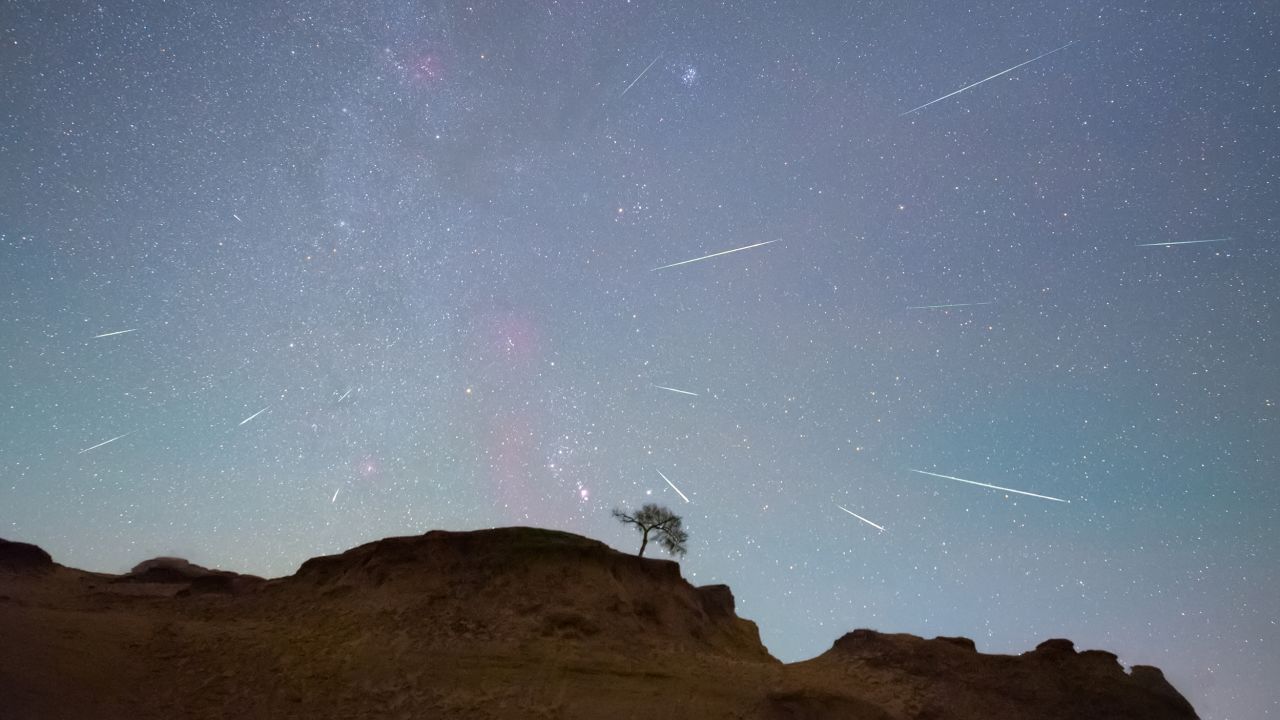() — One of nature’s most anticipated light shows will reach its peak this week, as space debris and dust trails from the famous Halley’s Comet scatter across the night sky.
The Orionid meteor shower is expected to peak at 2 pm ET on Friday, October 21, but is best seen earlier in that time zone, between the hours of midnight and sunrise. If viewed properly, away from bright lights and light-polluted areas, viewers can expect to see around 10 to 20 meteors per hour during this time, according to EarthSky.
When the meteor shower reaches its maximum, the Moon will approach a thin first quarter, and will no longer be bright enough to obscure the view of meteors. However, the head of NASA’s Meteorological Environment Office, Bill Cooke, suggests looking anywhere in the night sky that is far away from the Moon to best observe the fireballs.
The Orionid meteor shower is seen over the Songhua River in Daqing city, Heilongjiang province, China on October 22, 2020. The meteor shower will again be observable in both the northern and southern hemispheres on Oct. 21, 2022. Credit: Costfoto/Future Publishing/Getty Imag
“The eyes take about 45 minutes to adapt to the dark, so they can be more sensitive and see more finely. If you look at your bright phone, a street light, or the moon, you’ll screw up that night vision,” Cooke said.
The NASA recommends Go outside at least 30 minutes before meteor watching to adjust to the night sky.
“Watching a meteor shower takes time. Plan two hours or so outside, it’s not a 15-minute adventure,” Cooke added.
The meteor shower officially started on September 26 and will last until November 22, so sky watchers will still have a chance to see the Orionids after they peak.
The Orionids radiate outward from the constellation Orion the Hunter, specifically a point near Orion’s sword, near the great red star, Betelgeuse, but you don’t need to know the location of that point to see the meteors; They will appear in all parts of the sky.
No special equipment is needed to observe meteor showers, and the Orionids are visible from all regions of the world, weather permitting.
Origin of the Orionids
Although the shower’s name comes from the closest constellation, meteors are bits of dust left behind by Halley’s Comet in its orbit around the Sun. a journey that lasts about 76 years.
When the Earth’s orbit intersects with the trail of the comet’s orbit, we find the Orionids. In early May, we see these same particles at a different point in the comet’s orbit, but there they are called the Eta Aquarids.
“It happens about once in a person’s lifetime (for Halley’s Comet to be visible from Earth), once every 76 years, so everyone has a chance to see Halley’s Comet,” Cooke said. “For those of you who haven’t seen Halley’s Comet, if you don’t want to wait for it to come back, you can at least go out and see the Orionids.”
Halley’s Comet was last here in 1986 and will return in 2061, but the Orionids show up every year. Meteors are usually bright and fast-moving, often leaving behind persistent trails that can shine in the sky for a few seconds after they pass. The only other meteor showers that produce brighter fireballs are the Perseids and Geminids, according to Cooke.
In the years 2006 to 2009, the rate of meteors almost tripled, going from 20 per hour to 40, and sometimes up to 70 per hour. This was unexpected behavior caused by Jupiter’s gravitational pull, Cooke said.
“Meteor showers can surprise you,” he added. “This year, the forecast is for normal Orionid behavior, but you never know.”
Other space events this year
There are five other meteor showers you can watch in the remainder of 2022, according to the 2022 meteor shower guide from EarthSky:
– November 5: Southern Taurids
– November 12: Northern Taurids
– November 18: Leonidas
– December 14: Geminids
– December 22: Ursids
There are two more full moons on the calendar The Old Farmer’s Almanac by 2022:
– November 8: Beaver Moon
– December 7: cold moon
And there will be two more eclipses, one solar and one lunar, that will occur this year.
The partial solar eclipse on October 25 will be visible to people in Greenland, Iceland, most of Europe, northeast Africa, and western and central Asia. The total lunar eclipse on November 8 will be visible in Asia, Australia, the Pacific, South America and the western half of North America.










![[Img #74662]](https://thelatestnews.world/wp-content/uploads/2024/12/Organisms-with-the-shortest-life-150x150.jpg)



![[Img #74662]](https://thelatestnews.world/wp-content/uploads/2024/12/Organisms-with-the-shortest-life-300x200.jpg)
